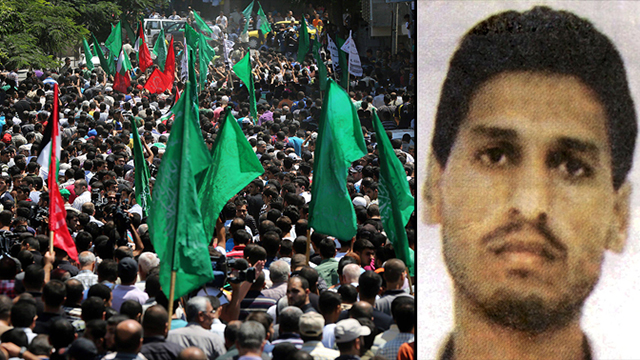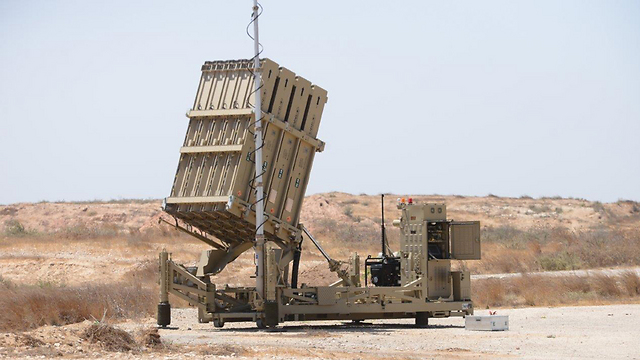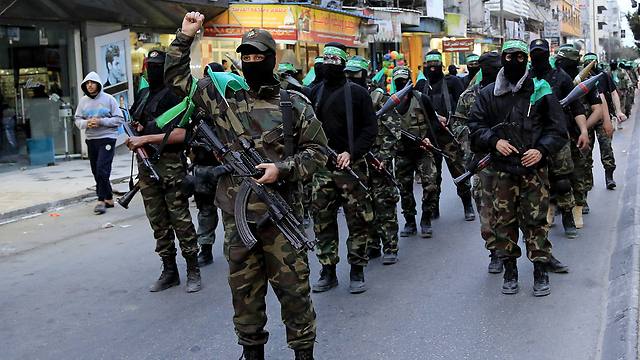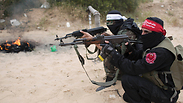
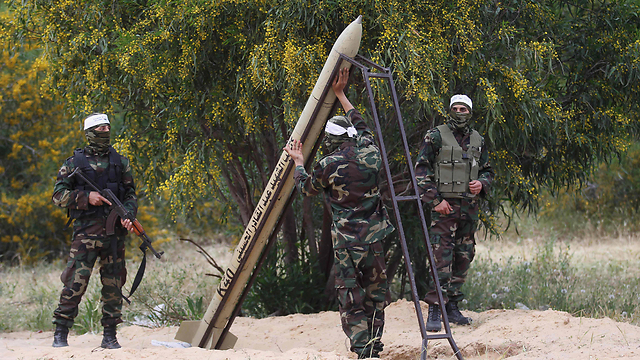
As Hamas grows stronger in Gaza, IDF prepares for future conflict
Hamas has upped the number of fighters in its elite and commando units and is testing short-range rockets with a heavy payload in an effort to restore its strength to what it was before summer 2014; the IDF, meanwhile, is planning to defeat Hamas's military wing and set them back years; 'We'll defeat them by offense, not defense,' says senior officer.
During a briefing to the media, a the senior IDF officer revealed some of the military's plans for a future conflict in Gaza. He also described a situation very similar to the period before the outbreak of Operation Protective Edge: Hamas in Gaza is pushing for an escalation of violence and trying to execute terror bombings in the West Bank - but is not interested in a confrontation with Israel in the Strip itself. At the same time, Hamas is dedicating most of its time and resources to restoring its military strength and further bolstering its forces.
"Hamas is suspicious of Israel, fearing that it will initiate a surprise attack on the Gaza Strip, which is why we're concerned that Hamas will miscalculate the situation," the officer said. "They're highly-sensitive about any statements made on our side."
IDF officials say that Hamas has been strongly deterred since Operation Protective Edge, particularly in light of the internal hardship in the Gaza Strip and Hamas's difficulty of finding another patron like Iran, which is demanding Hamas to declare its support of the axis in the civil war in Syria. Meanwhile, Egypt is giving Hamas the cold shoulder due to its ties with the Muslim Brotherhood. Indeed, Cairo views the Gaza group as aiding hundreds of ISIS jihadists in the Sinai.
Thirty-five rockets have been fired from Gaza at Israel since the end of Operation Protective Edge by other factions in the Strip. Most of these rockets either fell in open areas or were intercepted. Hamas, the official said, was quick to arrest those who violated the ceasefire.
"Hamas has established a border-protecting unit that enforces the ceasefire ad prevents terror attacks against Israel," he said.
"Even when roadside bombs went off - the last of which on Friday was an old IED - they were planted by other factions," he said. "Hamas sends us messages that it is working to stop attacks against us, that it remains restrained and that it is not interested in escalating the situation in the area because it is busy rehabilitating itself and the Strip. This view is shared by the IDF and other security forces, but we're not confused by it."
Hamas's military leadership is more dominant now, challenging the political leadership at every turn and turning them into mere figureheads. A good demonstration of that was in recent weeks when the military wing - commanded by Mohammed Deif, his deputy Marwan Issa, who is responsible for communications with the political leadership, and Yahya Sanwar, who was released as part of the Shalit deal and is largely seen as Hamas's "defense minister" - executed one of the organization's battalion commanders without seeking the approval of the political leadership - raising the ire of Hamas leader Khaled Mashal.
"The lessons the military wing learned from Operation Protective Edge is that they should not have listened to the political leadership as much as they did, because the political bureau failed to reach any achievements in the war," the official explained. "They also claim Hamas's political leadership limited them when it came to surprise attacks against Israel."
"You can't ignore the strength of the military wing in the Strip, which is supporting ISIS in the Sinai and making a series of appointments that are not to the liking of the political leadership," he added.
Investing in drones
The Military Intelligence Directorate has reported that the Hamas was investing a lot of time and resources in training its Nukhba force - the elite unit that will be sent to execute "quality operations" against Israel, like strategic bombings. The Nukhba unit has grown since the summer of 2014 and now numbers 5,000 fighters - out of Hamas's overall 20,000.
Hamas is also investing in the training of its naval commando unit as part of the lessons learned from Operation Protective Edge, when that unit tried to infiltrated the Zikim beach, was spotted by IDF lookouts, and gunned down. Now, the commando unit has far more divers than it had before.
Furthermore, Hamas is investing in the development of drones - with funds and knowhow from Iran.
When it comes to its production of rockets, Hamas has been hindered by a shortage of raw materials, mostly because the Egyptian military destroyed most of the smuggling tunnels connecting the Gaza Strip to the Sinai Peninsula. This has been making it harder on the terror group to restock its arsenal. Still, Hamas continues testing and developing rockets by firing middle- and long-range rockets into the sea in an effort to bypass the Iron Dome missile-defense system.
At the same time, Hamas is developing mortar shells and short-range rockets with very big payloads that could reach 150-200 kilograms per warhead - the kind of which they did not have before. Hamas chose to direct its resources thus as most of the Israelis killed by rocket fire during Operation Protective Edge were hit by the short-range fire to the border communities. In addition, Israel is limited when it comes to providing sufficient warning of short-range rockets, and limited in their interception.
However, "Hamas is not yet mass producing these mortar shells because of its difficulties in getting raw materials," the senior officer said.
In addition, the IDF has cautioned about continued attempts by Hamas to establish cells to attack Israel during war time from different fronts - including Lebanon and the Sinai, aided by ISIS militants in the peninsula.
Israel, the IDF officer noted, "has an interest in the Egyptian army defeating ISIS and not losing its control over northern Sinai. They're already operating against the smuggling to the Gaza Strip. We've approved most of their requests to bring land and air forces into the Sinai, temporarily, but some requests - like bringing artillery into the peninsula - were denied."
According to the IDF officer, there are three factors that could lead to the renewal of fighting in the south: One of the sides wrongly reading the situation because of a specific incident or declaration, escalation in light of incidents in the West Bank, and the Palestinians tiring of the Israeli military blockade and rising up against it.
'Aerial attacks will be more significant'
In order to prepare for a possible renewal of fighting, the IDF's top echelons have recently approved an operative plan to fighting in the Gaza Strip, formulated by the Southern Command.
"We have a plan to defeat Hamas's military wing based on different parameters that have been determined," the officer said. "Each of our battalions fighting on its way to its target will kill as many Hamas militants and damage as much of the organization's infrastructure as possible. The aim is to end the next campaign with Hamas's abilities set back by years. The plan is based on strong protection of the Gaza border communities, which will be done by the Gaza Division, while the IDF's gathering areas will be located far from the mortar shell threat."
The senior IDF officer further stated that "defeating Hamas will be achieved by offense, not defense, so we can initiate and not get dragged into it, not react to the enemy's moves. We need to surprise the enemy, and do so with great force. In addition, the aerial attacks will be much more significant and effective. Not just bombing for the sake of bombing. The plan will allow for different options - from a deterring strike to the full capture of the Gaza Strip. The plan could develop to the most extreme directions, and will enable us to deliver a very hard blow to the organization’s military wing."
However, it's important to mention, the IDF currently sees no alternative ruler for the Gaza Strip as Hamas still enjoys the support of the Palestinian street.
The senior officer said battalion commanders in the Southern Command have undergone a series of courses in different topics, including on how to defeat a Hamas battalion. "Each of our battalion commanders maneuvering in the Strip has a whole book about the battalion he'll fight against, including all of its details and characteristics," he said.
The senior officer said the plan also takes into consideration the possibility of having to evacuate communities close to the Gaza border. This will be done in coordination with the regional councils, while some personnel will remain in the communities to do vital work and defend the empty homes. The plan includes allocating communities to take in the residents of the evacuated towns.
In addition, pending financing promised by the government, the protection measures on the border fence will be increased in order to defend the nearby communities from mass protests on the fence of Palestinians trying to infiltrate Israel.
With all of that in mind, the Southern Command stressed that "there are no tensions in the south at the moment. We evaluate our preparedness in the Gaza border area as strong. The assessment right now is that there is not going to be an escalation of hostilities on the southern border in the near future and that the current situation will continue. The IDF will continue assessing the situation. There has been an improvement in the intelligence gathering and in the troops' preparedness."















